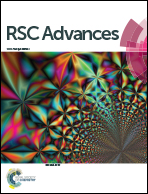Effective synthesis of highly fluorescent nitrogen doped carbon nanoparticles for selective sensing of Hg2+ in food and cosmetics samples†
Abstract
In recent years, extensive research has focused on fluorescent carbon nanoparticles (CNPs) due to their excellent photochemical, biocompatible and water-soluble properties. Doping CNPs with heteroatoms provided an attractive means of effectively tuning their intrinsic properties and exploiting new applications in the field of bioimaging and the environment. Herein, nitrogen doped carbon nanoparticles (N-doped CNPs) with a satisfactory quantum yield (36%) were prepared through a facile one-pot and solid-phase synthesis approach. The as prepared N-doped CNPs were relatively monodisperse with a narrow size distribution and uniform surface state. Furthermore, under the optimal conditions, the N-doped CNPs probe was used for the selective and sensitive determination of Hg2+. The limit of detection was 2.3 nM, with a wide concentration linear range of 0.0060–0.9 μM and 0.9–12.0 μM. This simple and green assay was employed for quick detection of Hg2+ in food and cosmetics samples with satisfactory results. The N-doped CNPs was also used as a new type of fluorescent ink due to their strong fluorescence effect and extremely high fluorescent quantum yield.


 Please wait while we load your content...
Please wait while we load your content...